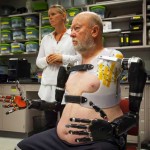 When I was at university (a long time ago), we received a guest lecture from Professor Kevin Warwick, who famously had chips implanted in his arm that were able to control bits of his nervous system.
When I was at university (a long time ago), we received a guest lecture from Professor Kevin Warwick, who famously had chips implanted in his arm that were able to control bits of his nervous system.
Suffice to say, things have come on significantly since then, and I written previously about developments in robotic gloves and prosthetic limbs.
The robotic gloves did tap into the muscular circuitry in the body to understand what the wearer was trying to do, but a second project by researchers at Johns Hopkins University aims to control a robotic arm using nothing but our thoughts.
Reading your mind
The researchers used the technique to attach the thought controlled arm to an amputee’s stump, thus significantly extending the motions that are possible.
The device is implanted into the bone at the end of the residual limb and allows patients to use the arm without any kind of harness.
“It’s all natural now,” a test patient says. “Nothing is holding me down. Before, I had limited range; I couldn’t reach over my head and behind my back. Now—boom!—that limitation is gone.”
Crucial to this project has been the development of a revolutionary socket, which connects the prosthesis to the stump. This is fundamental to the comfort of the user, and a badly fitting socket can ruin the experience for them.
The new device uses osseointegration to connect directly to the residual limb. This is achieved by inserting a fixture into the marrow space of the bone in the residual limb, with a titanium extension then added to the fixture that will eventually house the prosthesis.
Put through its paces
The device was put through its paces in the lab environment to explore the limits of its control and range of motion.
“We were conservative in our expectations,” the team say, “because we wanted to be cautious about how much load we were putting on the implant, how much we were asking him to do, and to make sure that we had a number of safety considerations in place and somewhat temper expectations for him.”
The test patient had come prepared however and had been working out with a weighted implant to be as ready as possible for the trial. This allowed him to demonstrate individual finger control, simultaneous finger control, 2 degrees of freedom at the wrist, and multiple grasps. He also worked through simulated activities of daily living.
The next step is to take the device out of the lab and into the real world. It’s a fascinating project, and you can find out more about it via the video below.
I reckon this is really cool and will help a lot of people. What a time to live in.
It is an incredible piece of technology that could have a huge impact.
The speed of progress in brain-computer interfaces is astounding. I hope that in my lifetime it allow paralysed people to function normally once again. Amazing.
It a race between building fully functioning artificial limbs and regrowing limbs and them attaching them to the patient.
Outstanding! What an incredible ray of hope for the unfortunate who have lost a limb.
The 'Age of the Machines' has arrived.